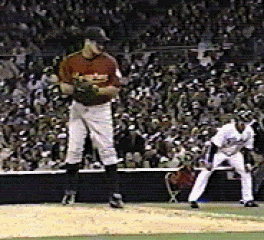Roy Oswalt and The Glide: Ideal Lower Half Mechanics

Roy Oswalt is one of my favorite pitchers in the big leagues. Everything about his arm action, lower half, intent to throw the ball, the way he approaches hitters, and his non-imposing figure – listed at just 6’0″, 190 lbs – made him one of the few pitchers in MLB that I thought represented “excellent” pitching mechanics.
While we don’t talk much about pitching mechanics in general on this blog, I want to introduce a basic concept of how the lower half should work in an efficient delivery. Of all the traits that Oswalt has, his “glide” to the plate is his best attribute and the one that sets him up to throw the ball at 90+ MPH with consistency.
This is a basic tenet of the National Pitching Association (NPA) – getting the butt down the hill quickly. I definitely agree with their characterization of this cue, but their other concepts tend to create a very linear pitcher with simple mechanics. This would be great, if it was how you could produce elite velocities. However, ASMI has shown (and our preliminary biomechanical research confirms) that the variables that correlate the most with increased fastball velocity are high rates of pelvic and shoulder rotational velocity. Linear momentum to the plate is great, but well below these two tenets when it comes to producing top shelf fastball velocities.
The Balance Point – Get it Out of Here
Teaching a pitchers to get to the “balance point” is a worthless exercise that will destroy their velocity and turn them into a linear pitcher. It is often used to cure “rushing” to the plate in youth pitchers in order to improve their control, but this is misguided at best. (This is a subject for another blog post, but focusing on control and command of pitches is one of the best ways you can destroy a youth pitcher’s future fastball velocity.)
Oswalt does not get to the balance point, and in truth, very few big league pitchers do. (Dan Haren is the notable exception.) Successful pitchers like Oswalt and Lincecum “drift” through the balance point, moving forward in a linear sense towards the plate well before maximum knee height. Doing this results in increased linear momentum to the plate, yes, but it also allows the pitcher to rotate their hips faster and later – two key variables required to develop elite fastball speed.
Comment section
Add a Comment
You must be logged in to post a comment.
Trip Somers -
I think the balance point has a place in teaching pitching mechanics. For me, it’s all about progression. It’s the equivalent of learning a trap bar deadlift instead of jumping straight into the conventional deadlift or learning box squats before deep Olympic squats.
Yeah, you’ll run into kids that naturally do this well from the first time you see them pitch, but as you mentioned, some kids rush badly because the glide is exaggerated and the upper body can’t catch up. The best way to remove the rush is to remove the glide, but not permanently, of course.
Things to Read: 7/5/2011 | Driveline Baseball -
[…] by Mike Robertson on assistance and accessory work for powering through those missed deadlifts.Roy Oswalt and the Glide: Ideal Lower Half Mechanics – A short post with a clip of Roy Oswalt’s lower half mechanics; he’s my favorite […]
Cromulent -
Kyle, help me understand precisely what you mean in “……..but it also allows the pitcher to rotate their hips faster and later”. And specifically I mean the word “rotate”. I’m not sure I see it in Oswalt here, but it seems most pitchers close or “load” the hips a little first before opening them. Now that rotation, from “open” to “closed”, when should it be taking place?